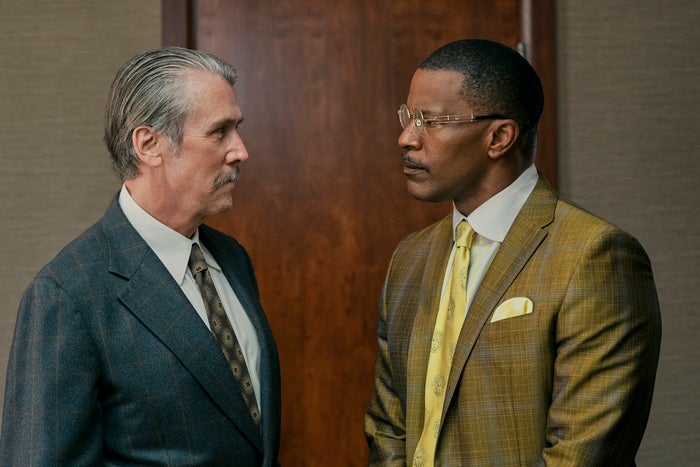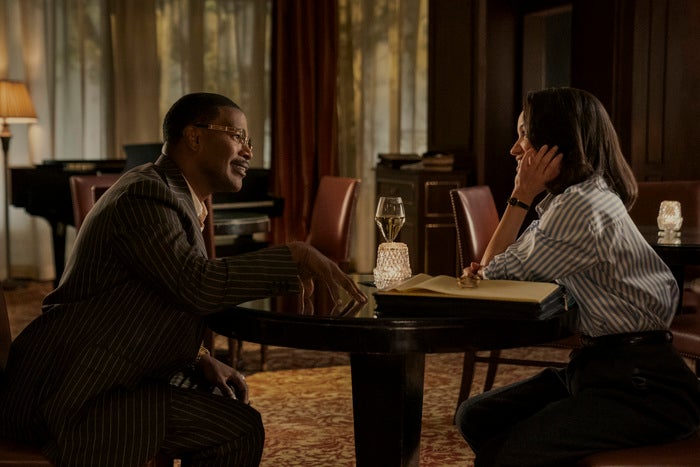“It’s like taking one history, and putting it right on top of another, like taking one man’s legacy and putting it right on top of another, until one day, it gets pushed down so deep, buried so deep, can’t no one ever find it no more,” Ruben Soames in The Burial (2023) by Maggie Betts.
Under the direction of Maggie Betts, The Burial, a film inspired by real-life events, shares the life story of Willie E. Gary, one of the nation’s most successful lawyers. This vibrant and entertaining drama not only shares the plight of small business owners who often fall prey to large conglomerates, it also sheds light on the unsung history of America’s Black Burial grounds. When Jerry O’Keefe, an owner of funeral homes, decides to take down a Goliath-size conglomerate, he finds an unlikely partnership in Gary that changes the trajectory of his life and generational legacy.
Starring Jamie Foxx (Willie Gary), Tommy Lee Jones (Jeremiah O’Keefe), Jurnie Smollett (Mame Downes), and Mamoudou Athie (Hal Dockins), The Burial begins in the Black church with Willie Gary charismatically engaging, swaying the congregation and giving praise. The beginning scene swiftly transitions to a courtroom, where Gary sways the jurors with this same power of persuasion that’s reminiscent of the call and response of the baptist church. While the film’s opening in a Southern Black church is typical, this film’s storyline does an excellent job of showcasing many positive themes and counter-narratives throughout. Themes such as positive representations of Black entrepreneurs achieving the American dream, the indisputable impact that nurturing Black mothers can have on their children (as seen in Willie E. Gary’s relationship with his mother), aspirational representations of marriage, as well as sharing parts of American history that are often erased from school history books, the erasure of Black towns and burial sites are all shared within The Burial.
 Alan Ruck as Mike Allred and Jamie Foxx as Willie Gary in The Burial
Alan Ruck as Mike Allred and Jamie Foxx as Willie Gary in The Burial
The Burial does a thorough job of denoting that there are moments in life that give us as human beings the opportunity to see that in many ways our similarities transcend our perceived differences. Both Willie Gary and Jeremiah O’Keefe want to leave a lasting legacy. Willie Gary doesn’t play small. Flashy suits, posh office suites, and sprawling real estate are his norm. Flying on the “Wings of Justice” is Gary’s preferred mode of transportation, and he fights in the court of law to win. O’Keefe, a small-town business owner who’s the patriarch of 12 kids, is content with his humble life until the generational legacy of business ownership that he plans to leave to his family is threatened. Despite their obvious differences, the common ground for both men, one Black and the other white, is their innate desire to sustain generational wealth for their families.
And, while the plot could have easily become overly saturated with racialized sentiments about systemic oppression, the succinct screenwriting of Betts, Doug Wright, and Jonathan Harr does an appreciable job of showing that regardless of one’s hardships, or humble beginnings as seen in the scenes discussing Gary’s life before sustaining success as a lawyer; with hard work and sheer determination, the American dream, no matter how elusive, can be attained. And, for Gary and O’Keefe, past struggle and hardship were the forces that propelled them both to fight for an expected end.
Due to strong screenwriting, hard truths about America’s history are shared with ease, and it is to be noted that despite having attained great success as a Black man, that Willie Gary is depicted as a man who was not afraid to stay connected to his roots. Beneath the bravado and confident gaze, Gary had the seeds of humility tucked away in his heart, and they were placed there by his mother, and the elders of his town.
In one of the most significant scenes in the movie, O’Keefe is driven by Willie’s wife Gloria Gary (Amanda Warren) to Willie’s childhood home. It is here, in this small, backwoods town, while sitting on the front porch, that his mother begins to speak about Willie’s personality and character as a small child. It’s revealed that Willie would rise at 4:30 AM and work in the fields as a child. It is in these scenes “back home” that the power of this film’s cinematography shines through. The simple, raw capture of dirt roads, tall grass in sugar cane fields, and small, quaint homes with precious porches help the storyline depict the necessity to look back to our roots to propel forward.
When Hal Dockins (played by Athie), a young, zealous attorney working with Gary and O’Keefe tips them off about new evidence for the case, a trip to Southern Mississippi reveals that beneath the green grass and sprawling fields lies generations of history, graves without headstones, entire cemeteries without markers, and even slave burial grounds that were completely demolished. At the end of this powerful scene, Ruben Soames (Fracaswell Hyman), a Black elder, reveals the hidden history of slave burial grounds. Soames passionately begins to state, “Our entire history, the history of Black people in the South, history of Black people in America, and the history of our slave ancestors, is buried everywhere out here. Deep underground, pretty much everywhere you look, that’s where our history is, in these vast empty fields. In some places, they put up all these statues, and confederate monuments, right on top of a slave burial field.” He further says, “It’s like taking one history, and putting it right on top of another, like taking one man’s legacy and putting it right on top of another, until one day, it gets pushed down so deep, buried so deep, can’t no one ever find it no more.” This scene reveals the power of oral storytelling, and why younger generations need to seek the good wisdom of their elders.
In The Burial, there are many positive counter-stereotypes, and the portrayal of wealthy, accomplished Black Americans is impactful. From Willie Gary’s all-Black staff of qualified lawyers working for him at his law firm to the well-educated lawyer Mame Downes (Jurnee Smollett), who hasn’t forgotten where she comes from, to the portrayal of academic excellence in this movie is both inspirational and empowering. There are not any negative portrayals of Black characters at all within this film. The characters are multidimensional, and all are portrayed with integrity, sophistication and grace. Mame Downes is a high-powered lawyer and reputable Harvard graduate, who leads a team of male lawyers. While Mame Downes is a fictitious character, the onscreen representation of a beautiful, Black woman who uses her intellect and critical thinking skills, instead of exploiting her beautiful physical appearance sends a powerful message to young women altogether. Her character gives a nod to historical female changemakers in the field of law such as Charlotte E. Ray, Pauli Murray, Jane Bolin, Barbara Jordan, Dorothy Crockett, and countless other Black lawyers who’ve made a mark in American history.
 Jamie Foxx as Willie Gary and Jurnee Smollett as Mame Downes in The Burial
Jamie Foxx as Willie Gary and Jurnee Smollett as Mame Downes in The Burial
Marriage as a soft place to land is another powerful theme in The Burial, and traditional marriage roles are not depicted in an oppressive manner, but rather showcase the benefits of having a supportive spouse. Despite Willie Gary and Jeremiah O’Keefe running businesses and being the sole breadwinners for their households, they both honored their wives. In one of the final scenes in the movie, O’Keefe does not make a final decision without consulting his wife. As a discerning husband, he is so in tune with his wife’s mannerisms, that she communicates with him only using body language in this scene, and he understands her completely. Similarly, despite being a multimillionaire lawyer with a confident persona, it is not a mistress or other women that Willie Gary turns to in his weakest moments. It is the wife of his youth, Gloria, that he calls and turns to in his most vulnerable moments. The Burial showcases some of the positive benefits of marriage without being overt or didactic.
Overall, The Burial is an aspirational movie that showcases positive images of Black families, and families, in general, for that matter. The narratives throughout the movie make room for viewers to have further discussions about the American dream, the benefits of hard work, the opportunities that higher education can provide, the importance of oral history being passed down from one generation to the next, and the impact that solidarity and business ownership can have long-term in historically disenfranchised communities.
Foxx, in his portrayal of Gary, is excellent, and he truly further solidifies his ability to take on any role that he inhabits. Jones as O’Keefe shows that he is a seasoned actor who understands what it means to breathe life into any character that he takes on. Smollett as Downes is believable. Amanda Warren as Gloria, and Pamela Reed as Annette O’Keefe both bring a unique authenticity and gentleness to the screen in their portrayals of traditional wives who embrace being of service to their husbands. Alan Ruck as Mike Allred and Bill Camp as Ray Loewen, both seamlessly embody their roles. There is something so genuine and earnest about Mamoudou Athie’s portrayal of Hal Dockins that it lingers in the mind long after his scenes. Not sure if it’s the youthfulness of his face, or the cadence of his voice, but Athie brings that subtle something special every time he appears on the screen. The entire lead and ensemble casting by Kim Coleman is top-notch. Lastly, the set locations coupled with the cinematography of Maryse Alberti make it easy to become enveloped in this visual picture of the Deep South.
The Burial is currently available to watch on Amazon Prime.
TOPICS: amazon prime video Jamie FoxxThe post ‘The Burial’ Highlights The History Of Black Burial Grounds appeared first on Essence.


0 Commentaires